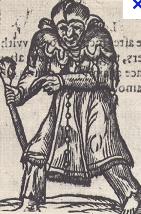All Hail the Male Witch! June 21, 2012
Author: Beach Combing | in : Medieval, Modern , trackbackWhy were witches, in the early modern period, women? The simple answer is that they were not. In all parts of Europe there were male witches and in some part of Europe male witches (witch = those put on trial for that crime) outnumbered narrowly or substantially the number of female witches. So at one end of the scale, in the Bishopric of Basel from 1571-1670 only nine male witches were tried, a mere 5% of the total. In nearby Venice from 1550-1650 24% of all cases were men. In Finland, 1520-1699, about half. In Normandy, 73% in the period 1564-1660. And in Iceland 92% of those tried were men from 1625-1685. The different dates here correspond to available records though, of course, a chronological breakdown within regions might show other interesting patterns.
Why were there these variations? The most obvious answer is that in some parts of Europe there was a stronger tradition of male magic. It is striking, for example, that Iceland and (tangentially) Normandy were part of the ‘Viking’ world were there was a strong pre-Christian tradition of the male sorcerer and likewise Finland probably had a Baltic male wizard thing going on. But sometimes this kind of geographical reconstruction leaves us without answers. If, for example, the Bishopric of Basel had 5% male witches, then how is that tolerably close Burgundy, over a similar period, found 52%? Beachcombing has no answers and has found no convincing attempts to satisfy that puzzle.
What is certainly the case is that in the European and Colonial imagination, at least in most regions, witches were female. Yet at the same time those male witches kept coming. Of the twenty one ‘witches’ put to death at Salem eight were men. And the last witch to be killed in Britain, albeit in an accidental lynching-drowning, was a man. Given the number of examples Beachcombing has seen of academic articles with the words ‘gendered’ in the title it would be tempting to bake up here a half done theory that these male witches were effeminate or, in some sense, women. But there is no evidence for this. There is no evidence of homosexual imagery and while witches mated with the devil it is unclear what male witches did to pledge their allegiance, apart from the standard anal-kissing. Were they sodomised by Satan or did they take part in the orgies at the Sabbat with other witches? Is there any other way to explain regional variations? drbeachcombing AT yahoo DOT com
***
Seditious writes in ‘”…it would be tempting to bake up here a half done theory that these male witches were effeminate or, in some sense, women.’ That’s possibly not such a half baked theory after all, at least in relation to the Viking world. In the Viking world magic was a highly gendered practice.’ It was a female art, and while there were male practitioners, being male and practicing seithr opened one up to accusations of unmanliness or effeminacy and potential persecution: see this Wikipedia entry for details. Ironically, the premierseithmathr was Odin himself, but of course for a Viking it wasn’t a matter of what you could do so much as what you could get away with doing. Thora Sharptooth also has this excellent article on witchcraft in the Viking age. Once again, you can see that it was accepted for women, but not for men. Basically, witchcraft seems to have been part of business as usual for women in the Viking world, but for men it was a transgressive act. Thus, it is actually possible that the statistics you’ve got represent a belief that witchcraft was most problematic when performed by males because it represented a transgression of gender roles and a failure to be sufficiently masculine.’ Wade, Invisible and Southern Man sent in this horrific story about a modern male witch who was born in the wrong country. Thanks Seditious!



